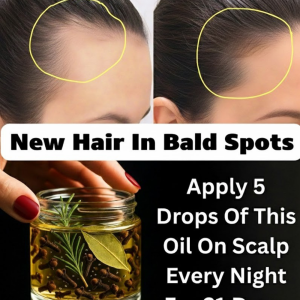Gray hair is one of the most visible signs of aging. While some embrace it as a badge of wisdom and elegance, others prefer to maintain their natural color for as long as possible. Commercial hair dyes can cover gray quickly, but many contain harsh chemicals that may weaken the hair or irritate the scalp. Fortunately, nature offers a gentler alternative: a simple preparation made with apple cider vinegar and rosemary.
Apple Cider Vinegar: A Traditional Hair Tonic

Apple cider vinegar has long been valued for both its health and cosmetic benefits. When applied to the hair, it can:
- Restore shine and vitality
- Balance the scalp’s natural pH
- Reduce the visibility of gray strands by evening out tones
- Strengthen hair fibers without chemical damage
Although it won’t completely cover gray hair, consistent use can improve texture and overall appearance.
Rosemary: Nature’s Hair Revitalizer
Rosemary is widely used in herbal beauty remedies for its stimulating properties. Applied to the scalp, it can:
- Boost circulation and encourage growth
- Refresh the scalp and reduce irritation
- Gently darken the hair, helping to soften the contrast of gray strands
When combined with apple cider vinegar, rosemary creates a nourishing treatment that supports healthier, fuller-looking hair while naturally reducing the prominence of gray.
How to Prepare and Use the Remedy

Ingredients:
- 10 dried rosemary sprigs
- 1/4 cup hot olive oil
- 5 drops rosemary essential oil
- Apple cider vinegar (undiluted)
Preparation:
- Crush the dried rosemary and place in a heat-resistant container.
- Add the hot olive oil and stir gently.
- Mix in the rosemary essential oil.
- Allow the blend to cool completely before use.
Application:
- On dry hair, apply the rosemary-oil mixture from roots to ends.
- Cover with a towel or shower cap and leave for about 45 minutes.
- Wash with a mild shampoo.
- Apply apple cider vinegar directly to gray areas, leave for a few minutes, then rinse.
Tips and Precautions
- Patch test first: Apply a small amount to your skin to ensure no allergic reaction occurs.
- Limit frequency: Two to three times per week is sufficient.
- Seek professional advice: If you have scalp conditions or sensitive skin, consult a dermatologist before use.
Long-Term Benefits

With regular use, this natural treatment may help you achieve:
- Shinier, healthier-looking hair
- Reduced visibility of gray strands
- A nourished, balanced scalp
- Less reliance on chemical dyes
Disclaimer: This content is for informational purposes only and does not replace medical or dermatological advice. Always consult a qualified professional before beginning new treatments, especially if you have existing skin or scalp conditions.




